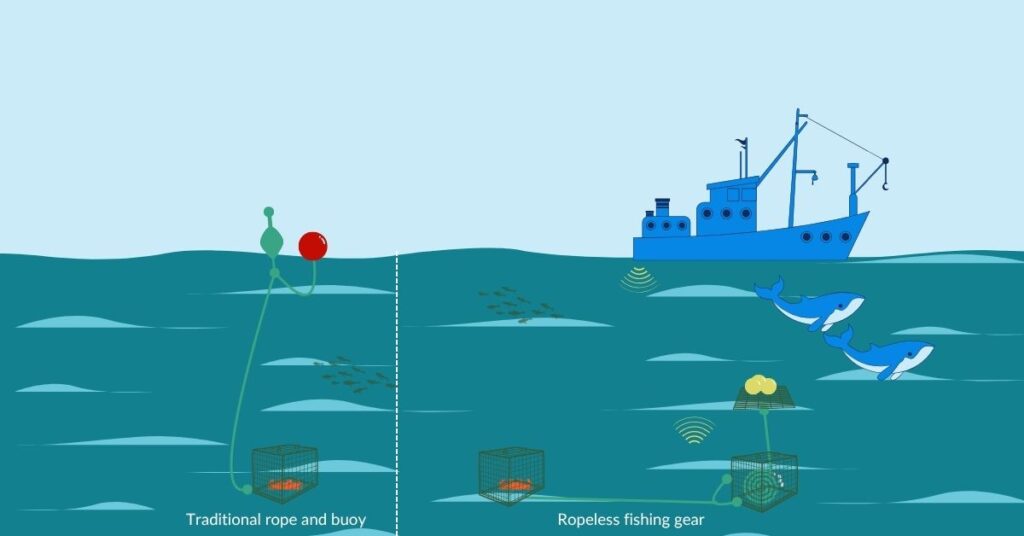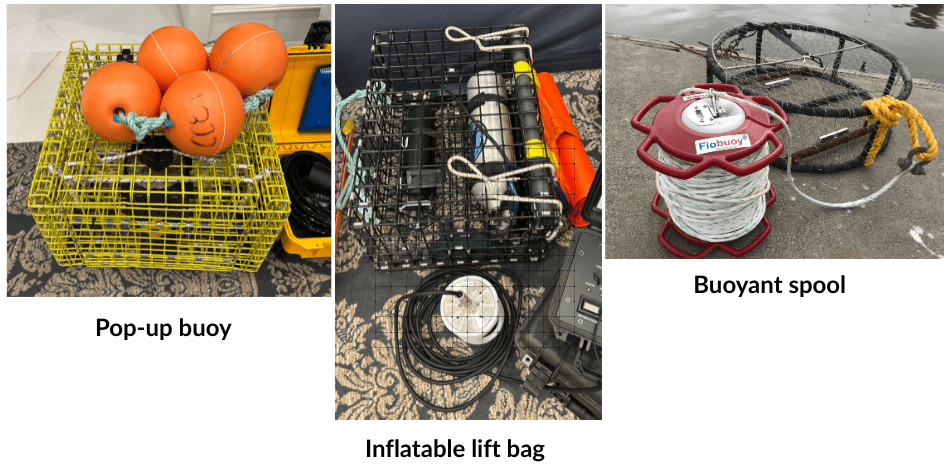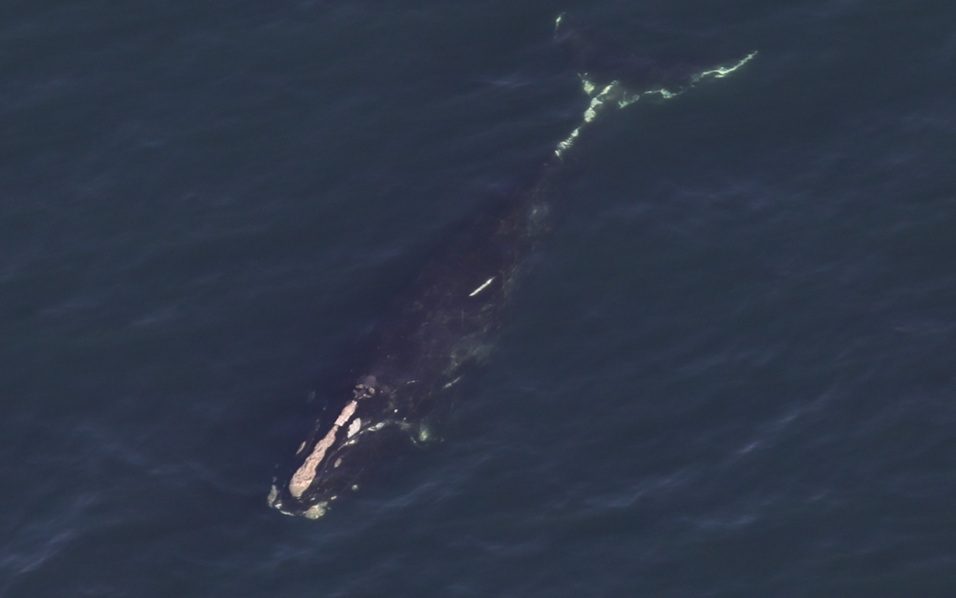What Is Ropeless or On-Demand Fishing Gear? Everything You Need to Know About this Whale Saving Technology
Estimated reading time: 0 minutes
BY: Hanna Vatcher
Entanglements in fishing gear cause serious injury and even death for critically endangered North Atlantic right whales. These slow-moving whales frequently become entangled in long vertical ropes that extend from surface buoys down to traps on the ocean floor. This threat is growing as right whales migrate through waters heavy with fishing to breed, feed and give birth. Here are just some of the recent tragic stories of right whales entangled in fishing gear:
- January 2024: a three-year-old whale calf was found dead near Martha’s Vineyard, off Massachusetts. A rope had cut deep into her tail causing her death. She had spent more than half of her short life suffering.
- January 2023: a whale named Argo was found entangled off the coast of North Carolina with heavy gear wrapped around his fluke. Argo was dragging two wire traps and over 150 feet of rope. A response team was able to free him, although he was in poor body condition and hasn’t been seen since.
Entanglements in fishing gear are common for right whales
More than 86% of North Atlantic whales have been entangled at least once. Some whales have even been entangled as many as eight times. In addition to the impact on the whales, these entanglements have consequences for fishers and coastal communities. Since 2017, Fisheries and Oceans Canada (DFO) has closed trap-based fishing areas (primarily snow crab and lobster) when right whales are seen in the area. Some of these closures are for the full fishing season. While such closures are currently necessary to protect whales , they also keep fishers from accessing valuable fishing grounds. Closures disrupt the seafood industry and the communities that rely on them. Ropeless gear is a solution that protects whales and allows fishers to continue fishing.

The problem with fishing ropes
Pot-based fishing, that has been used for generations, relies on millions of ropes hanging vertically in the ocean to retrieve the gear on the seafloor. These millions of kms of ropes create a dangerous maze that North Atlantic right whales must swim through. While some whales can swim free of a minor entanglement, many can’t and are left with deep wounds, painful infections, or broken bones. In the worst cases they eventually die from their injuries. Ropes can get wrapped around the whale’s tail, baleen (found inside their mouths), or fins — some even drag heavy gear for hundreds of kilometres, making it difficult for them to swim, feed or reproduce.
Ropeless gear: the solution to save right whales and allow fishers to fish
Ropeless fishing gear — also known “on-demand” or “pop-up” gear — can protect whales by removing vertical ropes from the water. Here’s how the technology works:
- 1. Set the traps: Fishers place traps on the ocean floor, attached to a ropeless unit that stores the rope and float. Since there is no vertical rope, there is no risk of entangling whales or other marine life such as sea turtles and sharks.
- 2. Mark and track: Using GPS and a mobile app, fishers log the location of each trap. The system also shows where others have set gear, reducing the risk of traps at the same location.
- 3. Call and retrieve: When it’s time to retrieve the gear, fishers send an acoustic signal to the ropeless unit. The float and rope are released to the surface, allowing the traps to be hauled up with their catch.

This innovative approach uses technology to help protect whales while supporting sustainable fishing.
Types of ropeless gear
There are currently three main types of ropeless fishing gear systems available. Each is designed to reduce the risk of entanglement to right whales and other marine animals, while allowing fishers to continue to fish.
- Pop-up buoy: Buoys connect to the top of a trap, with a coiled vertical rope inside. When signaled, the lid of the trap detaches and the buoys — attached to the rope — rise to the surface.
- Inflatable lift bag: An empty air bag connects to the outside of a trap, along with compressed air canisters. When signaled, the canister inflates the bag, lifting the trap to the surface
- Buoyant spool: Rope is coiled around a buoyant spool and attaches to the outside of the trap. When signaled, the spool is released and floats to the surface, uncoiling the rope as it ascends

Fishers in Canada are using all three of these types of ropeless gear in trials. Credit Hanna Vatcher (photo one and two) and Geoff Shester (photo three).
Current and future use of ropeless fishing gear in Canada
Fishers are testing and using ropeless gear systems on a limited basis in parts of eastern Canada, along the migratory route of right whales. Snow crab and lobster fisheries are among the early adopters. To support broader access, the CanFISH Gear Lending Program launched in 2022 to help harvesters borrow ropeless gear during a fishery closure triggered by whale sightings.
While ropeless gear offers the potential to reduce entanglements and support economic resilience, widescale implementation depends on the viability for harvesters. Transitioning to this requires investment in new gear, change to operations and crew training — all of which come with challenges and learning curves. Early adopters , especially in gear testing, improve functionality and build trust in these systems. Expanding gear lending programs and trial opportunities also encourage more harvesters to participate.
Right whales and communities that rely on fishing can’t wait. Ropeless gear is effective — and it’s time to implement it in all areas that pose a high-risk of entanglement for whales.
Entanglement in fishing gear threatens whales. Add your name to the petition calling for the implementation of ropeless fishing gear that protects marine life and helps keep fishers on the water.

MOST RECENT
June 19, 2025
June 2, 2025
OPINION: From Crisis to Opportunity: Rebuilding Canada’s Fisheries for Climate and Economic Security

